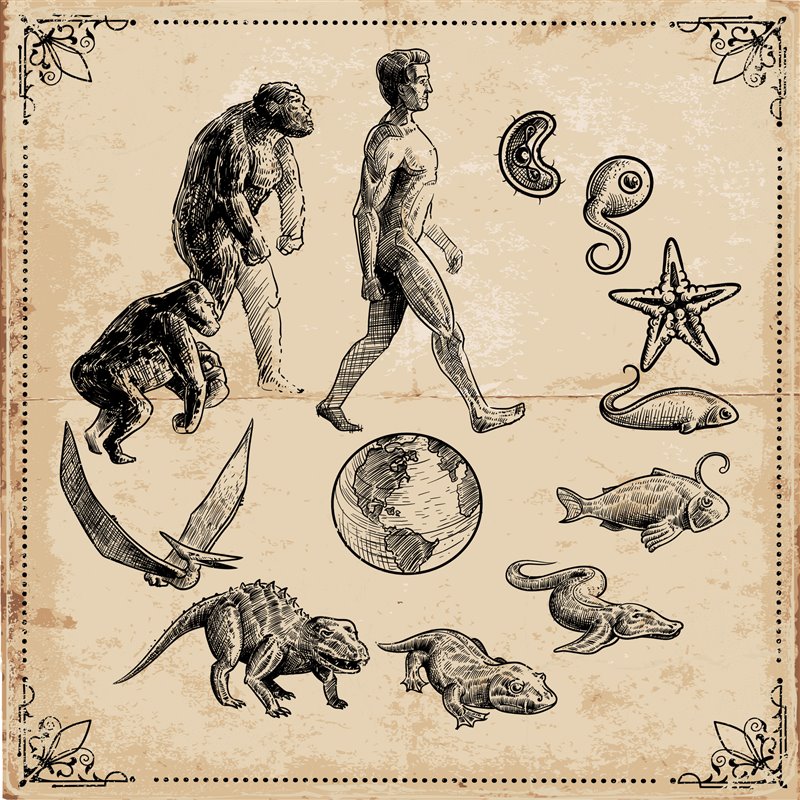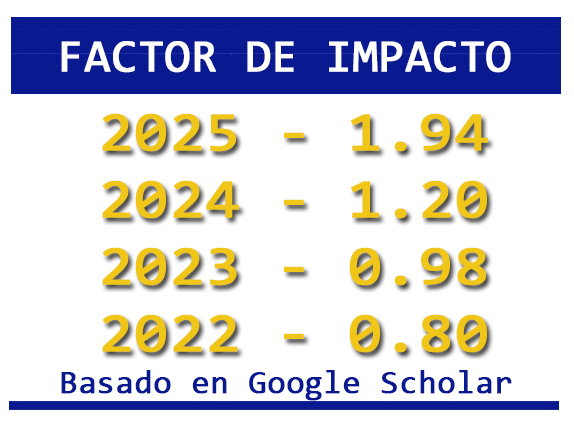El impacto de la teoría evolutiva en nuestra concepción de la naturaleza
DOI:
https://doi.org/10.36790/epistemus.v17i35.298Palabras clave:
Evolución, selección natural, cambio, ancestro común, primatesResumen
El presente ensayo expone, en tres ejes centrales, el impacto que ha tenido la teoría evolutiva en la concepción que posee la humanidad sobre la naturaleza, la biodiversidad y sobre sí misma. Primeramente, se plantea cómo los avances científicos nos han ayudado a concebir la dinámica de los procesos biológicos de la naturaleza. Después, la relación filogenética que los humanos tenemos con el resto de las especies biológicas que existen y han existido en el planeta, y los linajes evolutivos que nos unen con un ancestro común. Por último, los estudios etológicos, morfológicos, fisiológicos, bioquímicos y genéticos, soportan las similitudes que compartimos con los mamíferos y en especial con el resto de los primates. Solo 1% de las características genéticas nos diferencian de especies como los chimpancés y los bonobos, son estas diferencias las que han permitido que Homo sapiens haya realizado proezas como llegar hasta la luna o enviar...
Descargas
Citas
. J. O. A. Onyeka, “The relevance of biological sciences in the 21st century”, Bio-Res., vol. 1, núm. 1, 2004. https://doi.org/10.4314/br.v1i1.28513 DOI: https://doi.org/10.4314/br.v1i1.28513
. E. Watts y U. Kutschera, “On the historical roots of creationism and intelligent design: German Allmacht and Darwinian evolution in context”, Theory Biosci., vol. 140, núm. 2, pp. 157–168, 2021. https://doi.org/10.1007/s12064-021-00341-x DOI: https://doi.org/10.1007/s12064-021-00341-x
. A. Laats, “An eternal monkey trial? Evolution and creationism in U.S. schools”, Phi Delta Kappan, vol. 102, núm. 5, pp. 24–28, 2021. https://doi.org/10.1177/0031721721992561 DOI: https://doi.org/10.1177/0031721721992561
. F. Pelayo, «El impacto del darwinismo en la sociedad española del siglo XIX», Hispania Nova, pp. 310-329, ene. 2016.
. T. Dobzhansky, “Nothing in biology makes sense except in the light of evolution”, Am. Biol. Teach., vol. 35, núm. 3, pp. 125–129, 1973. https://doi.org/10.2307/4444260 DOI: https://doi.org/10.2307/4444260
. L. Al-Shawaf, D. M. G. Lewis, N. Barbaro, y Y. S. Wehbe, “The products of evolution: Conceptual distinctions, evidentiary criteria, and empirical examples”, en The SAGE Handbook of Evolutionary Psychology, 1 Oliver’s Yard, 55 City Road London EC1Y 1SP: SAGE Publications Ltd, 2021, pp. 70–95. https://doi.org/10.4135/9781529739442.n5 DOI: https://doi.org/10.4135/9781529739442.n5
. C. Rahbek et al., “Building mountain biodiversity: Geological and evolutionary processes”, Science, vol. 365, núm. 6458, pp. 1114–1119, 2019. DOI: 10.1126/science.aax0151 DOI: https://doi.org/10.1126/science.aax0151
. F. J. Cuen Romero, E. Chacón-Baca, J. Moreno-Bedmar, y M. P. Velasco-de León, “FÓSILES: HISTORIA DE LA VIDA EN LA TIERRA”, Epistemus, vol. 14, núm. 28, 2021. DOI: 10.36790/epistemus.v14i28.124 DOI: https://doi.org/10.36790/epistemus.v14i28.124
. S. L. Brusatte et al., “The extinction of the dinosaurs: Dinosaur extinction”, Biol. Rev. Camb. Philos. Soc., vol. 90, núm. 2, pp. 628–642, 2015. DOI: 10.1111/brv.12128 DOI: https://doi.org/10.1111/brv.12128
. G. Ceballos, P. R. Ehrlich, y P. H. Raven, “Vertebrates on the brink as indicators of biological annihilation and the sixth mass extinction”, Proc. Natl. Acad. Sci. U. S. A., vol. 117, núm. 24, pp. 13596–13602, 2020. https://doi.org/10.1073/pnas.192268611 DOI: https://doi.org/10.1073/pnas.1922686117
. D. M. Raup, “The role of extinction in evolution”, Proc. Natl. Acad. Sci. U. S. A., vol. 91, núm. 15, pp. 6758–6763, 1994. DOI: 10.1073/pnas.91.15.6758 DOI: https://doi.org/10.1073/pnas.91.15.6758
. P. Raia et al., “Past extinctions of homo species coincided with increased vulnerability to climatic change”, One Earth, vol. 3, núm. 4, pp. 480–490, 2020. https://doi.org/10.1016/j.oneear.2020.09.007 DOI: https://doi.org/10.1016/j.oneear.2020.09.007
. S. Akanuma, “The common ancestor of all modern life”, en Astrobiology, Singapore: Springer Singapore, 2019, pp. 91–103. DOI: 10.1007/978-981-13-3639-3_7 DOI: https://doi.org/10.1007/978-981-13-3639-3_7
. A. R. McCune y J. C. Schimenti, “Using genetic networks and homology to understand the evolution of phenotypic traits”, Curr. Genomics, vol. 13, núm. 1, pp. 74–84, 2012. DOI: https://doi.org/10.2174/138920212799034785 DOI: https://doi.org/10.2174/138920212799034785
. A. J. Doig, “Frozen, but no accident - why the 20 standard amino acids were selected”, FEBS J., vol. 284, núm. 9, pp. 1296–1305, 2017. https://doi.org/10.1111/febs.13982 DOI: https://doi.org/10.1111/febs.13982
. E. V. Koonin y A. S. Novozhilov, “Origin and evolution of the genetic code: the universal enigma”, IUBMB Life, vol. 61, núm. 2, pp. 99–111, 2009. doi: 10.1002/iub.146 DOI: https://doi.org/10.1002/iub.146
. M. C. Weiss, M. Preiner, J. C. Xavier, V. Zimorski, y W. F. Martin, “The last universal common ancestor between ancient Earth chemistry and the onset of genetics”, PLoS Genet., vol. 14, núm. 8, p. e1007518, 2018. https://doi.org/10.1371/journal.pgen.1007518 DOI: https://doi.org/10.1371/journal.pgen.1007518
. A. Thanukos, “Bringing homologies into focus”, Evolution (N. Y.), vol. 1, núm. 4, pp. 498–504, 2008. https://doi.org/10.1007/s12052-008-0080-5 DOI: https://doi.org/10.1007/s12052-008-0080-5
. K. Prüfer et al., “The bonobo genome compared with the chimpanzee and human genomes”, Nature, vol. 486, núm. 7404, pp. 527–531, 2012. https://doi.org/10.1038/nature11128 DOI: https://doi.org/10.1038/nature11128
. A. Sánchez-Amaro y F. Rossano, “Chimpanzees and bonobos use social leverage in an ultimatum game”, Proc. Biol. Sci., vol. 288, núm. 1962, p. 20211937, 2021. https://doi.org/10.1098/rspb.2021.1937 DOI: https://doi.org/10.1098/rspb.2021.1937
. J. M. Engelmann et al., “Chimpanzees consider alternative possibilities”, Curr. Biol., vol. 31, núm. 20, pp. R1377–R1378, 2021. https://doi.org/10.1016/j.cub.2021.09.012 DOI: https://doi.org/10.1016/j.cub.2021.09.012
. J. B. Harrod, “The chimpanzee stone accumulation ritual and the evolution of moral behavior”, en Synthese Library, Cham: Springer International Publishing, 2021, pp. 63–86. https://doi.org/10.1007/978-3-030-68802-8_4 DOI: https://doi.org/10.1007/978-3-030-68802-8_4
. N. Kawai y T. Matsuzawa, “Numerical memory span in a chimpanzee: Cognition”, Nature, vol. 403, núm. 6765, pp. 39–40, 2000. https://doi.org/10.1038/47405 DOI: https://doi.org/10.1038/47405
. Q. Ji, W. Wu, Y. Ji, Q. Li, y X. Ni, “Late Middle Pleistocene Harbin cranium represents a new Homo species”, Innovation (N Y), vol. 2, núm. 3, p. 100132, 2021. https://doi.org/10.1016/j.xinn.2021.100132 DOI: https://doi.org/10.1016/j.xinn.2021.100132
. I. Hershkovitz et al., “A Middle Pleistocene Homo from nesher Ramla, Israel”, Science, vol. 372, núm. 6549, pp. 1424–1428, 2021. https://doi.org/10.1126/science.abh3169 DOI: https://doi.org/10.1126/science.abh3169
. F. Chen et al., “A late Middle Pleistocene Denisovan mandible from the Tibetan Plateau”, Nature, vol. 569, núm. 7756, pp. 409–412, 2019. https://doi.org/10.1038/s41586-019-1139-x DOI: https://doi.org/10.1038/s41586-019-1139-x
. C. Liu, “A cathedral with disconnected chapels? Reassessing the cognitive capacities of Neanderthals in light of recent archaeological discoveries”, J. Cogn. Cult., vol. 21, núm. 3–4, pp. 243–260, 2021. https://doi.org/10.1163/15685373-12340107 DOI: https://doi.org/10.1163/15685373-12340107
. I. Tattersall, “History and reality of the genus ‘Homo’: What is it and why do we think so?”, Mètode Rev. difus. investig., vol. 0, núm. 8, 2017. https://doi.org/10.7203/metode.8.911 DOI: https://doi.org/10.7203/metode.8.9111
. H. M. Dunsworth, “Origin of the genus homo”, Evolution (N. Y.), vol. 3, núm. 3, pp. 353–366, 2010. https://doi.org/10.1007/s12052-010-0247-8 DOI: https://doi.org/10.1007/s12052-010-0247-8

Publicado
Cómo citar
Número
Sección
Licencia
Derechos de autor 2023 EPISTEMUS

Esta obra está bajo una licencia internacional Creative Commons Atribución-NoComercial-CompartirIgual 4.0.
La revista adquiere los derechos patrimoniales de los artículos sólo para difusión sin ningún fin de lucro, sin menoscabo de los propios derechos de autoría.
Los autores son los legítimos titulares de los derechos de propiedad intelectual de sus respectivos artículos, y en tal calidad, al enviar sus textos expresan su deseo de colaborar con la Revista Epistemus, editada semestralmente por la Universidad de Sonora.
Por lo anterior, de manera libre, voluntaria y a título gratuito, una vez aceptado el artículo para su publicación, ceden sus derechos a la Universidad de Sonora para que la Universidad de Sonora edite, publique, distribuya y ponga a disposición a través de intranets, internet o CD dicha obra, sin limitación alguna de forma o tiempo, siempre y cuando sea sin fines de lucro y con la obligación expresa de respetar y mencionar el crédito que corresponde a los autores en cualquier utilización que se haga del mismo.
Queda entendido que esta autorización no es una cesión o transmisión de alguno de sus derechos patrimoniales en favor de la mencionada institución. La UniSon le garantiza el derecho de reproducir la contribución por cualquier medio en el cual usted sea el autor, sujeto a que se otorgue el crédito correspondiente a la publicación original de la contribución en Epistemus.
Salvo indicación contraria, todos los contenidos de la edición electrónica se distribuyen bajo una licencia de uso y Attribution-NonCommercial-ShareAlike 4.0 International (CC BY-NC-SA 4.0) Puede consultar desde aquí la versión informativa y el texto legal de la licencia. Esta circunstancia ha de hacerse constar expresamente de esta forma cuando sea necesario.















